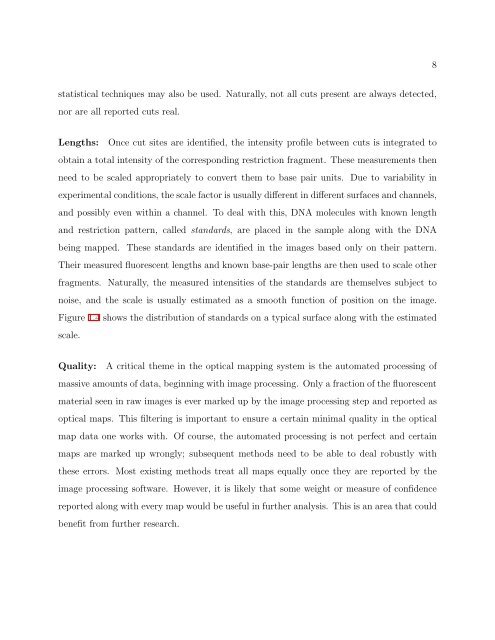On the Analysis of Optical Mapping Data - University of Wisconsin ...
On the Analysis of Optical Mapping Data - University of Wisconsin ...
On the Analysis of Optical Mapping Data - University of Wisconsin ...
Create successful ePaper yourself
Turn your PDF publications into a flip-book with our unique Google optimized e-Paper software.
8<br />
statistical techniques may also be used. Naturally, not all cuts present are always detected,<br />
nor are all reported cuts real.<br />
Lengths: <strong>On</strong>ce cut sites are identified, <strong>the</strong> intensity pr<strong>of</strong>ile between cuts is integrated to<br />
obtain a total intensity <strong>of</strong> <strong>the</strong> corresponding restriction fragment. These measurements <strong>the</strong>n<br />
need to be scaled appropriately to convert <strong>the</strong>m to base pair units. Due to variability in<br />
experimental conditions, <strong>the</strong> scale factor is usually different in different surfaces and channels,<br />
and possibly even within a channel. To deal with this, DNA molecules with known length<br />
and restriction pattern, called standards, are placed in <strong>the</strong> sample along with <strong>the</strong> DNA<br />
being mapped. These standards are identified in <strong>the</strong> images based only on <strong>the</strong>ir pattern.<br />
Their measured fluorescent lengths and known base-pair lengths are <strong>the</strong>n used to scale o<strong>the</strong>r<br />
fragments. Naturally, <strong>the</strong> measured intensities <strong>of</strong> <strong>the</strong> standards are <strong>the</strong>mselves subject to<br />
noise, and <strong>the</strong> scale is usually estimated as a smooth function <strong>of</strong> position on <strong>the</strong> image.<br />
Figure 1.4 shows <strong>the</strong> distribution <strong>of</strong> standards on a typical surface along with <strong>the</strong> estimated<br />
scale.<br />
Quality: A critical <strong>the</strong>me in <strong>the</strong> optical mapping system is <strong>the</strong> automated processing <strong>of</strong><br />
massive amounts <strong>of</strong> data, beginning with image processing. <strong>On</strong>ly a fraction <strong>of</strong> <strong>the</strong> fluorescent<br />
material seen in raw images is ever marked up by <strong>the</strong> image processing step and reported as<br />
optical maps. This filtering is important to ensure a certain minimal quality in <strong>the</strong> optical<br />
map data one works with. Of course, <strong>the</strong> automated processing is not perfect and certain<br />
maps are marked up wrongly; subsequent methods need to be able to deal robustly with<br />
<strong>the</strong>se errors. Most existing methods treat all maps equally once <strong>the</strong>y are reported by <strong>the</strong><br />
image processing s<strong>of</strong>tware. However, it is likely that some weight or measure <strong>of</strong> confidence<br />
reported along with every map would be useful in fur<strong>the</strong>r analysis. This is an area that could<br />
benefit from fur<strong>the</strong>r research.
















